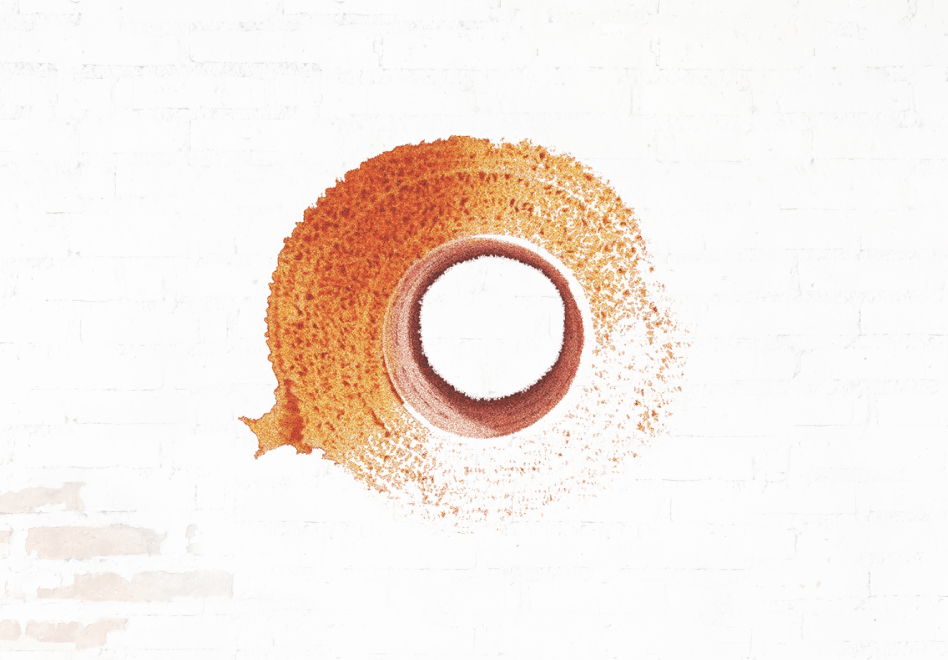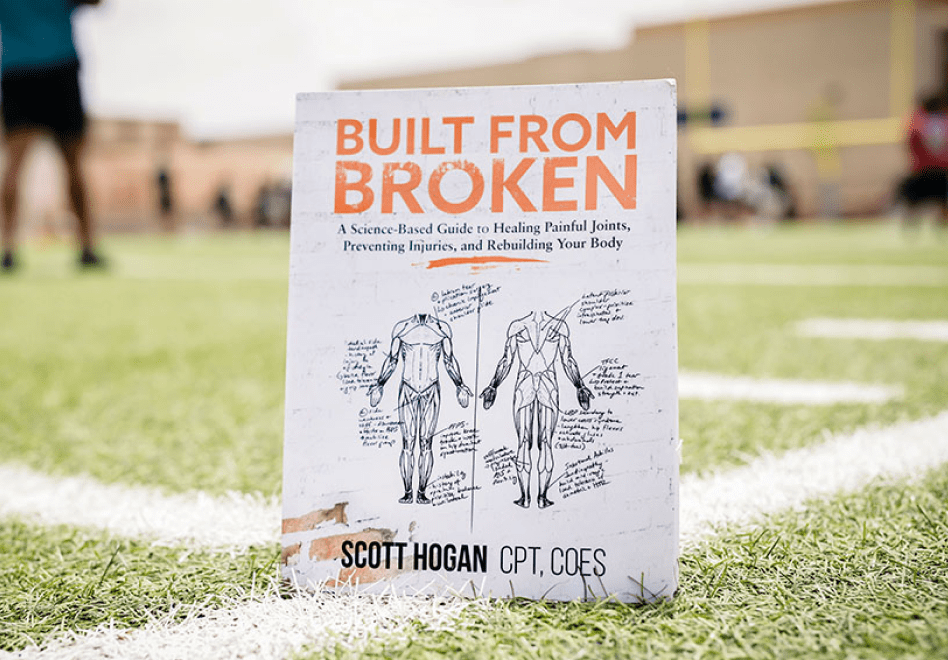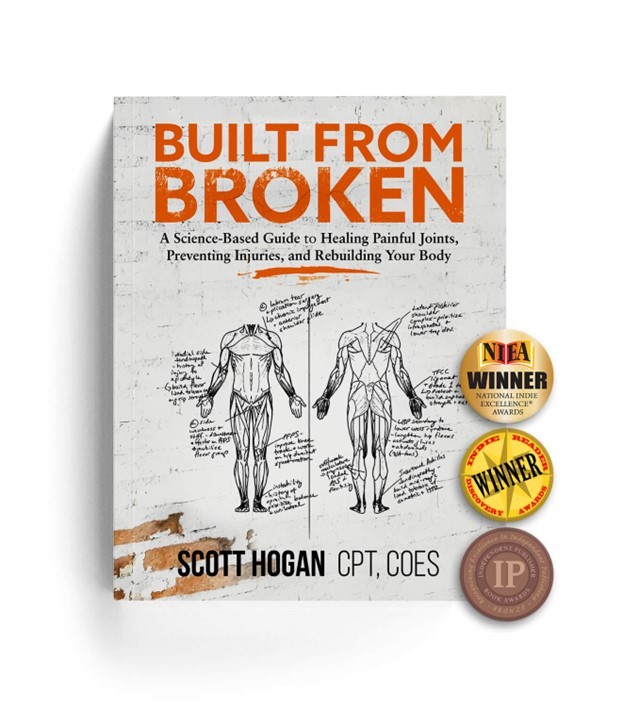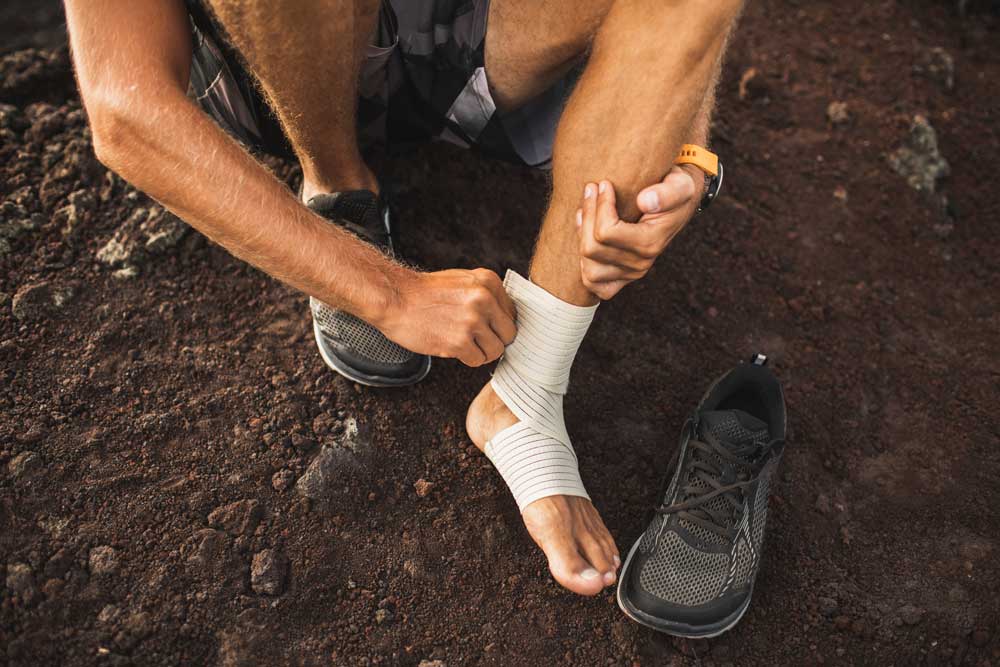
Be built (to last).
The right supplements can help you recover naturally and build a resilient body.

Supplement Quiz
Take this short quiz to discover the perfect supplements for your needs and goals.
About SaltWrap

Built from Broken
Get the best-selling book from SaltWrap founder, Scott Hogan, and start rebuilding today.
The 3 Best Exercises for Shoulder Pain From Impingement
by Scott Hogan, ACE-CPT, COES
Shoulder pain is one of the most common complaints among athletes and everyday fitness enthusiasts. Even people who don’t exercise regularly experience it. This is because of the shoulder’s unique anatomy. Unlike the hips, which rely on a bony anatomical structure for stability, shoulders rely on muscles and connective tissue.1
By definition, shoulders are among the least stable of human joints because of their hypermobility. This creates a perfect storm for pain and injury. But I’m going to show you how to get relief with three of the best exercises for shoulder pain.

Shoulder Impingement: Causes and Symptoms
First, let’s take a look at one of the leading causes of shoulder pain.
Up to 65% of doctor’s visits for shoulder pain are caused by shoulder impingement.2 This happens when soft tissues are pinched between the bony structures of the shoulder. The primary symptoms are pain during specific movements and reduced pain-free ranges of motion. There are a few different classifications of shoulder impingement, but the most common – and preventable – type is subacromial impingement. This is commonly called swimmer’s shoulder.
This happens when the supraspinatus tendon – a member of the rotator cuff family – and other soft tissues become pinched in the subacromial space. That’s the small gap between your acromion bone (on the top) and the head of your humerus bone (on the bottom).

What Does Shoulder Impingement Feel Like?
Shoulder impingement typically presents as a dull, throbbing ache in the front of the shoulder joint. This pain is usually intermittent, with flare-ups during pushing movements and while laying in bed at night.
The 3 Best Exercises for Shoulder Impingement
These three exercises address all the fundamental causes of shoulder impingement-related pain. They also provide a healthy therapeutic stimulus for healing damaged tendons. At the end of the article, I explain how to program these into your weekly schedule.
Before jumping in, ensure your shoulder is healthy enough to complete these movements safely. If you’ve been dealing with mild shoulder pain for months or longer, you’re likely dealing with some level of tendinosis – a degeneration of the tendon’s collagen base in response to repetitive stress. This makes you a great candidate for implementing these exercises right away to help repair those damaged collagen structures.
(But if you have severe or sharp pain, or are concerned you may be dealing with a more serious injury, get clearance from your doctor or physical therapist first.)
The Bottoms-Up Kettlebell Press
The Bottoms-Up Kettlebell Press is the closest thing I’ve found to a magic bullet for shoulder pain. And it will put your ego in its place. Instead of the round part of the kettlebell facing downward, you will hold it “bottom up.” Because of the challenging stabilization component, you’ll have to use a weight much lighter than you would typically use for a dumbbell overhead press or standard kettlebell overhead press.
Unlike a dumbbell or machine press, the kettlebell starting position forces you to move through a range of motion that creates more space for your rotator cuff tendon to glide freely without scraping on bony structures.
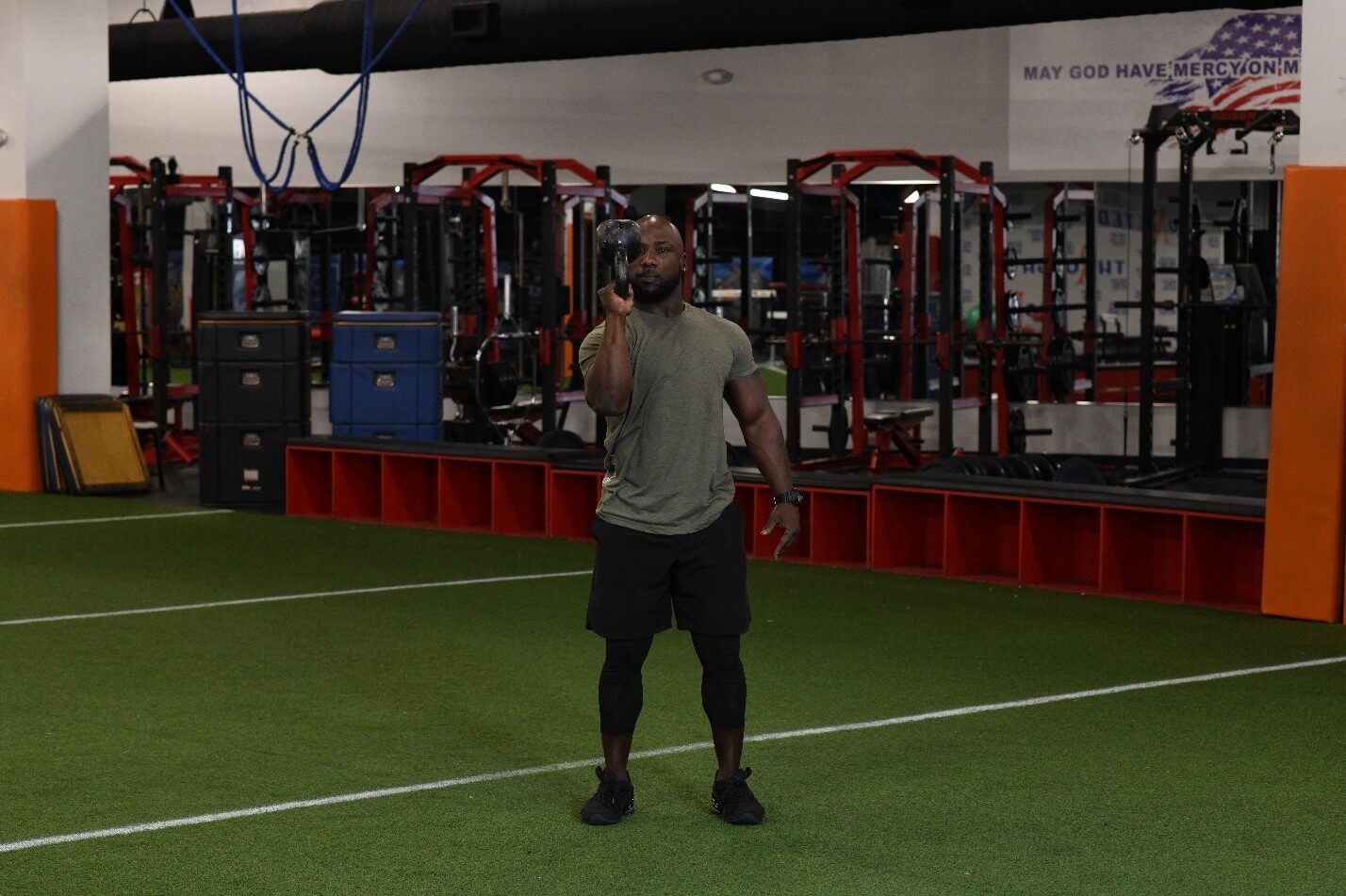
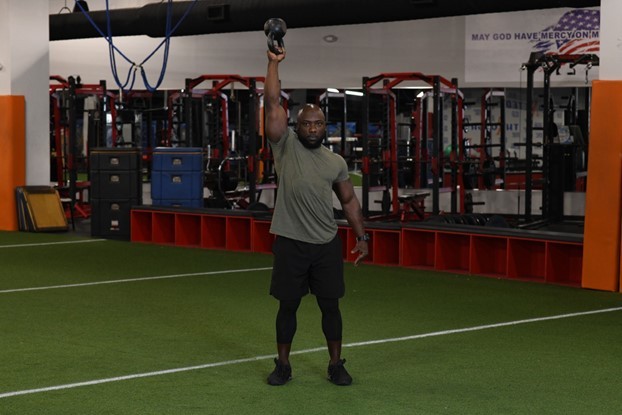
Above: The Bottoms-Up Kettlebell Press is the closest thing to a "magic bullet" for shoulder pain.
Substitute this exercise for:
-
Barbell Military Press
-
Machine Shoulder Press
-
Dumbbell Shoulder Press
-
Bench Press (That's right! Try taking a week off from the bench press and use this instead. Your shoulders will thank you.)
Setup
Stand with your feet shoulder-width apart, holding a kettlebell in one hand. Either swing the kettlebell up or use a two-handed grip to safely get to the starting position. To start the pressing movement, the kettlebell should be balanced just in front of your shoulder at about chin height. Keep a firm grip on the handle to prevent the weight from wobbling.
Execution
Brace your core and push the weight straight over your head, finishing with your arm pointed straight up in the air and the kettlebell balanced in the bottoms-up position. You will notice that to extend your arm fully, the weight will travel slightly behind you as you press it up. If you have tight lats, getting into the overhead position may be a challenge at first.
Hold the weight in the extended position briefly before slowly reversing the motion.
Scapular Plane Raise
This exercise can be performed with a dumbbell or resistance band.
Unlike a typical front or side dumbbell raise that isolates the deltoid muscles, the Scapular Plane Raise trains scapula stability and total shoulder joint strength. More importantly, research shows that it more effectively maintains the subacromial space during motion, preventing shoulder impingement.3
This exercise is one of the best ways to introduce challenging load stimulus to damaged tendons without overstressing them. The key is to go slow. No jerky movements here.
For more details on this strategy, check out this article on how to use slow-tempo exercises to heal damaged tendons.
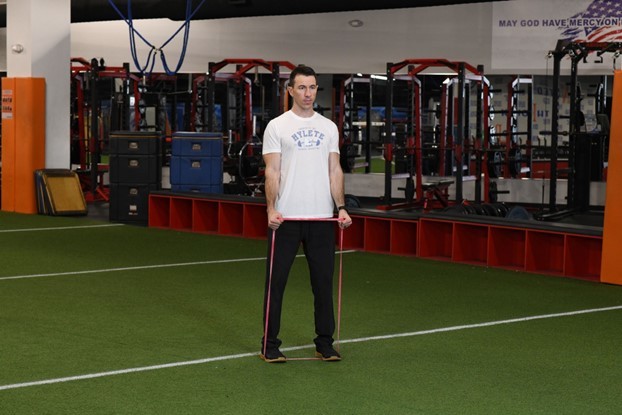
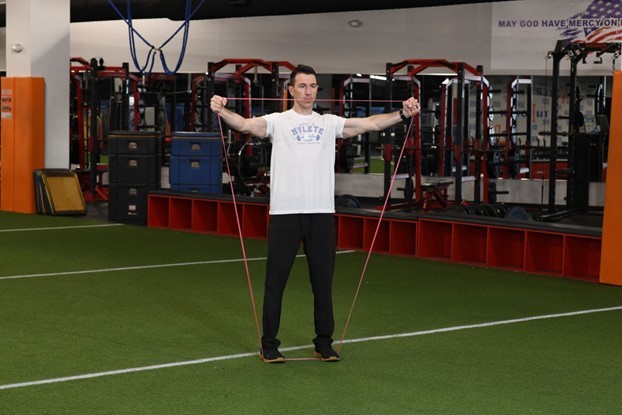
Above: the Scapular Plane Raise trains scapula stability and total shoulder joint strength.
Substitute this exercise for:
-
Dumbbell Front Raise
-
Dumbbell Side Raise
-
Upright Row
Setup
Stand with feet shoulder-width apart, holding a pair of dumbbells by your sides with elbows slightly bent. For the band version, step on the band and grab each side so that resistance is equal between both arms.
Execution
With a thumbs-up, neutral grip, raise your arms out to the sides of your body and just slightly forward – about 30 to 45 degrees. Stop the motion when your arms are parallel to the ground. Control the weight at the top of the movement by pausing briefly before slowly lowering the weights back down.
Incline Dumbbell High Row
This variation is performed lying face down on an incline bench, but with a different arm angle to the body than the standard dumbbell row.
Instead of keeping your elbows close to your body, flare them out to the sides. This places more emphasis on the external rotation muscles of your upper back, and less emphasis on your lats (which internally rotate).
Compared to other back exercises, this is more effective for balancing the muscles between the front and rear of your upper body. This helps prevent shoulder impingement.

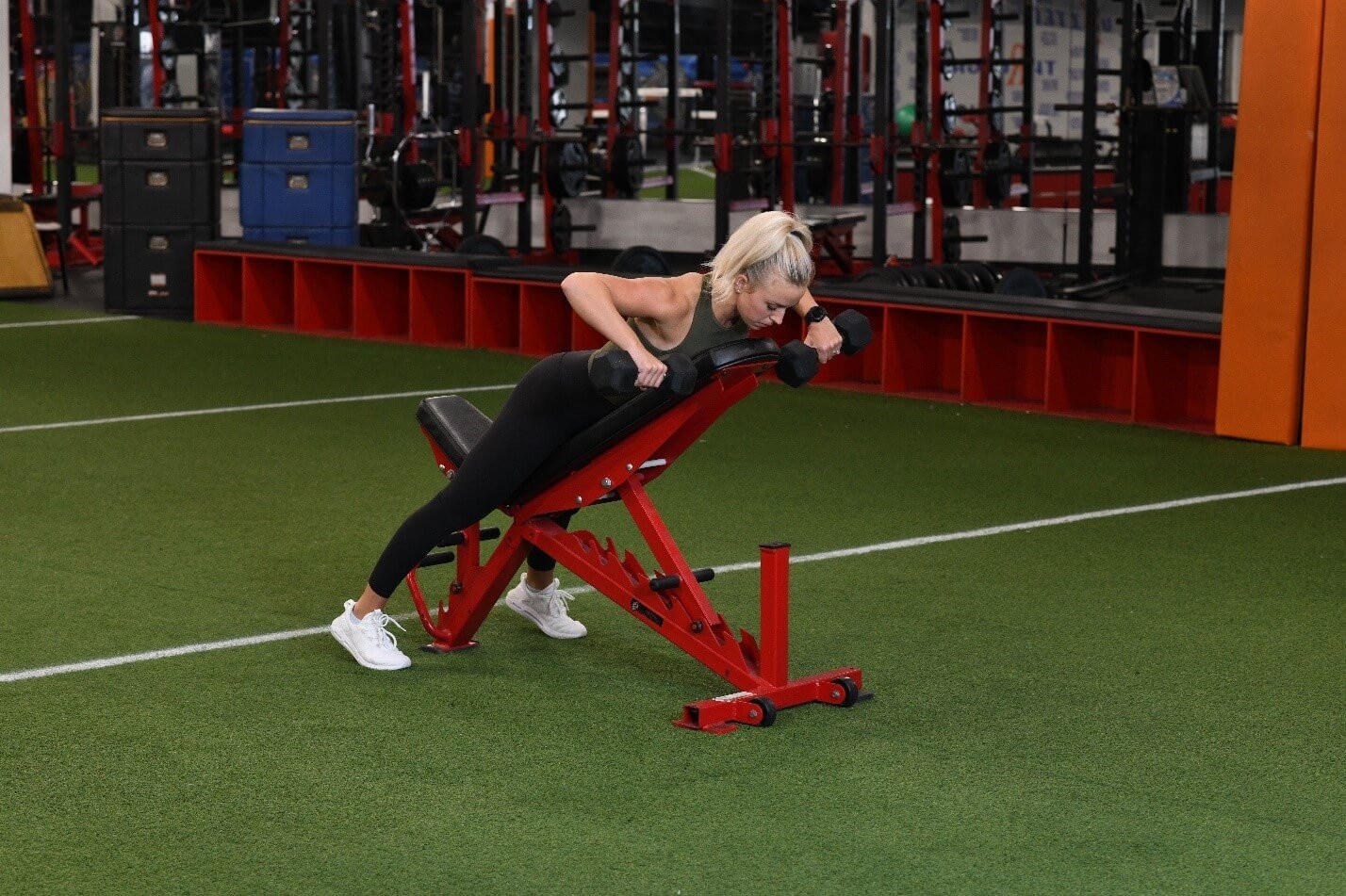
Above: compared to other back exercises, the Incline Dumbbell High Row is more effective for balancing the muscles between the front and rear of your upper body.
Substitute this exercise for:
-
Lat Pulldown
-
Barbell Row
-
Machine Row
Setup
Lie face-down on an incline bench set to around 45 degrees, with dumbbells held in each hand.
Execution
Initiate the movement by pulling your elbows away from your body and toward the ceiling. Aim for a 90-degree angle between your upper arm and forearm at the top of the movement, pausing momentarily before slowly lowering the weights.
How to Program These Exercises To Prevent Shoulder Impingement
If you lift weights most days or follow a body part-focused routine, perform these exercises at least once weekly when you train your shoulders. Aim for 3-4 sets of each exercise. And prioritize these movements before other shoulder exercises.
If you exercise only three or four days per week, use these movements as a dynamic warm-up. Perform 1-2 sets using light weights and slow movement tempos before you start your regular upper body exercise routine. Do this 2-3 times per week.
For more guidance on sets, repetitions, and how to build a weekly schedule, the training programs in Built From Broken are just what you’re looking for.
Finally, it’s worth noting that if you are recovering from a recent shoulder injury, or your shoulder pain is too great to perform these exercises comfortably, you may want to start with a more focused approach that addresses a common underlying cause of shoulder impingement: poor scapular function.
Check out the section below from Clinical Advisory Board member and Doctor of Physical Therapy, Alaina Curry, on how she approaches patients with impingement symptoms.
Clinical Advisory Board Commentary

Alaina Curry, DPT
Doctor of Physical Therapy, NSCA CSCS, and Former NCAA All-American Athlete
These exercises, especially the Bottoms-up Kettlebell Press, are great for an end-stage rehab or a general shoulder health program to prevent impingement symptoms.
However, when treating patients with impingement symptoms, whether internal or external joint issues, I like to start by addressing their shoulder mechanics.
More specifically, their scapular mechanics.
Can they fully retract and rotate their shoulder blade downward to perform a rowing exercise adequately?
In patients with shoulder pathologies, it’s common to see the arm elevate and the shoulder blade not move enough. Or move too much (winging scapula). After diagnosing the potential shoulder pathology and identifying any movement impairments, I will then program a unique regimen that helps build neuromuscular control of the entire shoulder girdle.
But let’s back up a moment.
Shoulder impingement is almost always involved when dealing with shoulder pathologies in the joint (internal) and joint structures (external).
For instance, a rotator cuff injury can cause enough inflammation that the subacromial space (external) becomes impinged with overhead movements. Or, an injury to the labrum (internal) can cause similar impingement symptoms.
I see this very often in my practice. For example, many baseball players experience internal impingement from the repetitive stress on the labrum from throwing.
In their case, I first address the throwing mechanics. How is the scapula moving in addition to the shoulder joint? Most of the time, the scapulothoracic and scapulohumeral rhythm/movement pattern is faulty. This is why the scapula is often the best place to start.
In most cases, the first piece that needs to be addressed is if an individual can protract and upwardly rotate their scapula enough to clear the shoulder from ramming into the subacromial space.
For many patients, I like to start with an exercise called the serratus punch.
Think of it as extending your arm – almost like throwing a jab – using only scapular protraction. These are typically performed with patients lying on their backs. We often start without extra resistance. But we may eventually “graduate” to light dumbbells or bands.
From there, to address the other side of the coin, I would typically have patients perform a one-arm cable or band row.
The twist here is that they start the movement with their scapula fully protracted – not unlike the top of the serratus punch movement, but in a standing position (grasping the cable or band). Then, they retract their scapula back into what would be considered the starting position of a conventional standing cable or band row.
Just as a patient might graduate to using a dumbbell for the serratus punch, in the case of the row, rather than just adding resistance, we might make this movement more challenging by performing it on an incline bench.
These scapular movements aren’t exclusive to injury rehabilitation. They can work very well preventively, too.
For instance, perhaps you don’t have shoulder pain because there hasn’t been repetitive stress to increase inflammation and thus create pain with overhead movement. Yet you may still move your arm overhead with faulty mechanics. Then, it’s likely only a matter of time until you feel shoulder pain from doing overhead pressing movements like this.
As I noted, the Bottoms-up Kettlebell Press is an excellent exercise for stability once scapular mechanics and stability have been addressed. I often use this exercise in my practice. In fact, for some patients, I like to start with the elbow at 90 degrees in the scapular plane. Then, rather than pressing overhead, I have them stabilize and hold that position while walking to challenge the rotator cuff stability.
When in doubt, start with the scapula!
How Long Does It Take for Shoulder Impingement To Heal?
It can take months, or sometimes years, for shoulder pain from impingement to escalate to the point of being debilitating. So expect to spend several weeks or months reprogramming movement patterns and rebuilding damaged collagen structures.
But if you can avoid the movements that exacerbate your pain, and add the movements I just showed you to your repertoire, you’ll be on your way to building rock-solid, pain-free shoulders.
-
Change, L. R, Anand, P. Varacallo, M. (2020). Anatomy, shoulder and upper limb, glenohumeral joint. StatPearls. https://www.ncbi.nlm.nih.gov/books/NBK537018/
-
van der Windt, D. A., Koes, B. W., de Jong, B. A., & Bouter, L. M. (1995). Shoulder disorders in general practice: Incidence, patient characteristics, and management. Annals of the Rheumatic Diseases, 54(12), 959–964. https://pubmed.ncbi.nlm.nih.gov/8546527/
-
Escalante, G. (2016). Exercise modification strategies to prevent and train around shoulder pain. Strength and Conditioning Journal, 39. https://www.researchgate.net/publication/312266298_Exercise_Modification_Strategies_to_Prevent_and_Train_Around_Shoulder_Pain
Founder: Scott Hogan

I created SaltWrap to bring together the most practical ideas in therapeutic sports nutrition, corrective exercise, and functional fitness — with the goal of keeping you (and myself) strong, mobile, and built to last.
I've worked as an A.C.E. Certified Personal Trainer, Orthopedic Exercise Specialist, and nutritional supplement formulator.
But more importantly — I've spent most of my life battling injuries, joint pain, and just being plain beat up. So I know what it's like to struggle toward fitness goals.
SaltWrap is here to push you through injuries, setbacks and perceived physical limitations. To a place beyond what you think you're capable of. Sign up here to stay in the loop.
Learn more about my best-selling injury prevention and recovery book, Built from Broken.

